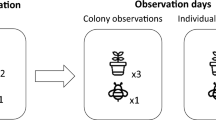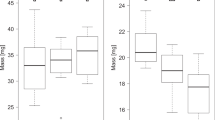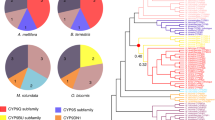Abstract
Intensive agriculture currently relies on pesticides to maximize crop yield1,2. Neonicotinoids are the most widely used insecticides globally3, but increasing evidence of negative impacts on important pollinators4,5,6,7,8,9 and other non-target organisms10 has led to legislative reassessment and created demand for the development of alternative products. Sulfoximine-based insecticides are the most likely successor11, and are either licensed for use or under consideration for licensing in several worldwide markets3, including within the European Union12, where certain neonicotinoids (imidacloprid, clothianidin and thiamethoxam) are now banned from agricultural use outside of permanent greenhouse structures. There is an urgent need to pre-emptively evaluate the potential sub-lethal effects of sulfoximine-based pesticides on pollinators11, because such effects are rarely detected by standard ecotoxicological assessments, but can have major impacts at larger ecological scales13,14,15. Here we show that chronic exposure to the sulfoximine-based insecticide sulfoxaflor, at dosages consistent with potential post-spray field exposure, has severe sub-lethal effects on bumblebee (Bombus terrestris) colonies. Field-based colonies that were exposed to sulfoxaflor during the early growth phase produced significantly fewer workers than unexposed controls, and ultimately produced fewer reproductive offspring. Differences between the life-history trajectories of treated and control colonies first became apparent when individuals exposed as larvae began to emerge, suggesting that direct or indirect effects on a small cohort may have cumulative long-term consequences for colony fitness. Our results caution against the use of sulfoximines as a direct replacement for neonicotinoids. To avoid continuing cycles of novel pesticide release and removal, with concomitant impacts on the environment, a broad evidence base needs to be assessed prior to the development of policy and regulation.
This is a preview of subscription content, access via your institution
Access options
Access Nature and 54 other Nature Portfolio journals
Get Nature+, our best-value online-access subscription
$29.99 / 30 days
cancel any time
Subscribe to this journal
Receive 51 print issues and online access
$199.00 per year
only $3.90 per issue
Buy this article
- Purchase on Springer Link
- Instant access to full article PDF
Prices may be subject to local taxes which are calculated during checkout


Similar content being viewed by others
References
Foley, J. A. et al. Global consequences of land use. Science 309, 570–574 (2005).
Tilman, D., Cassman, K. G., Matson, P. A., Naylor, R. & Polasky, S. Agricultural sustainability and intensive production practices. Nature 418, 671–677 (2002).
Simon-Delso, N. et al. Systemic insecticides (neonicotinoids and fipronil): trends, uses, mode of action and metabolites. Environ. Sci. Pollut. Res. Int. 22, 5–34 (2015).
Woodcock, B. A. et al. Impacts of neonicotinoid use on long-term population changes in wild bees in England. Nat. Commun. 7, 12459 (2016).
Tsvetkov, N. et al. Chronic exposure to neonicotinoids reduces honey bee health near corn crops. Science 356, 1395–1397 (2017).
Rundlöf, M. et al. Seed coating with a neonicotinoid insecticide negatively affects wild bees. Nature 521, 77–80 (2015).
Woodcock, B. A. et al. Country-specific effects of neonicotinoid pesticides on honey bees and wild bees. Science 356, 1393–1395 (2017).
Whitehorn, P. R., O’Connor, S., Wackers, F. L. & Goulson, D. Neonicotinoid pesticide reduces bumble bee colony growth and queen production. Science 336, 351–352 (2012).
Feltham, H., Park, K. & Goulson, D. Field realistic doses of pesticide imidacloprid reduce bumblebee pollen foraging efficiency. Ecotoxicology 23, 317–323 (2014).
Pisa, L. et al. An update of the worldwide integrated assessment (WIA) on systemic insecticides. Part 2: impacts on organisms and ecosystems. Environ. Sci. Pollut. Res. Int. https://doi.org/10.1007/s11356-017-0341-3 (2017).
Brown, M. J. F. et al. A horizon scan of future threats and opportunities for pollinators and pollination. PeerJ 4, e2249 (2016).
Commission Implementing Regulation (EU) 2015/1295 of 27 July 2015 approving the active substance sulfoxaflor, in accordance with Regulation (EC) No 1107/2009 of the European Parliament and of the Council concerning the placing of plant protection products and amending the Annex to Commission Implementing Regulation (EU) No 540/2011 https://publications.europa.eu/en/publication-detail/-/publication/e5aad62c-35b1-11e5-9f85-01aa75ed71a1/language-en (European Commission, 2015).
Milner, A. M. & Boyd, I. L. Toward pesticidovigilance. Science 357, 1232–1234 (2017).
Bryden, J., Gill, R. J., Mitton, R. A. A., Raine, N. E. & Jansen, V. A. A. Chronic sublethal stress causes bee colony failure. Ecol. Lett. 16, 1463–1469 (2013).
Baron, G. L., Jansen, V. A. A., Brown, M. J. F. & Raine, N. E. Pesticide reduces bumblebee colony initiation and increases probability of population extinction. Nat. Ecol. Evol. 1, 1308–1316 (2017).
Bass, C., Denholm, I., Williamson, M. S. & Nauen, R. The global status of insect resistance to neonicotinoid insecticides. Pestic. Biochem. Physiol. 121, 78–87 (2015).
Zhu, Y. et al. Discovery and characterization of sulfoxaflor, a novel insecticide targeting sap-feeding pests. J. Agric. Food Chem. 59, 2950–2957 (2011).
Longhurst, C. et al. Cross-resistance relationships of the sulfoximine insecticide sulfoxaflor with neonicotinoids and other insecticides in the whiteflies Bemisia tabaci and Trialeurodes vaporariorum. Pest Manag. Sci. 69, 809–813 (2013).
Perry, T. et al. Effects of mutations in Drosophila nicotinic acetylcholine receptor subunits on sensitivity to insecticides targeting nicotinic acetylcholine receptors. Pestic. Biochem. Physiol. 102, 56–60 (2012).
Sparks, T. C. et al. Differential metabolism of sulfoximine and neonicotinoid insecticides by Drosophila melanogaster monooxygenase CYP6G1. Pestic. Biochem. Physiol. 103, 159–165 (2012).
Gill, R. J., Ramos-Rodriguez, O. & Raine, N. E. Combined pesticide exposure severely affects individual- and colony-level traits in bees. Nature 491, 105–108 (2012).
Henry, M. et al. A common pesticide decreases foraging success and survival in honey bees. Science 336, 348–350 (2012).
Baron, G. L., Raine, N. E. & Brown, M. J. F. General and species-specific impacts of a neonicotinoid insecticide on the ovary development and feeding of wild bumblebee queens. Proc. R. Soc. B 284, 20170123 (2017).
Samuelson, E. E. W., Chen-Wishart, Z. P., Gill, R. J. & Leadbeater, E. Effect of acute pesticide exposure on bee spatial working memory using an analogue of the radial-arm maze. Sci. Rep. 6, 38957 (2016).
Siviter, H., Koricheva, J., Brown, M. J. F. & Leadbeater, E. Quantifying the impact of pesticides on learning and memory in bees. J. Appl. Ecol. https://doi.org/10.1111/1365-2664.13193 (2018).
Stanley, D. A. et al. Neonicotinoid pesticide exposure impairs crop pollination services provided by bumblebees. Nature 528, 548–550 (2015).
United States Environmental Protection Agency. 2016 Addendum to the Environmental Fate and Ecological Risk Assessment for Sulfoxaflor Registration (2016).
Pest Management Regulatory Agency. Registration Decision RD2016–12, Sulfoxaflor https://canada.ca/en/health-canada/services/consumer-product-safety/reports-publications/pesticides-pest-management/decisions-updates/registration-decision/2016/sulfoxaflor-rd2016-12.html (2016).
Alford, D. V. Bumblebees (Davis-Poynter, London, 1975).
Wu, J. Y., Anelli, C. M. & Sheppard, W. S. Sub-lethal effects of pesticide residues in brood comb on worker honey bee (Apis mellifera) development and longevity. PLoS ONE 6, e14720 (2011).
Syngenta Canada. Visivio Seed Treatment https://www.syngenta.ca/Productsdetail/Visivio (2018).
Centner, T. J., Brewer, B. & Leal, I. Reducing damages from sulfoxaflor use through mitigation measures to increase the protection of pollinator species. Land Use Policy 75, 70–76 (2018).
Dow AgroSciences South Africa. Closer 240 SC http://www.dowagro.com/en-za/southafrica/products/insecticide/closer-240-sc (2018).
Dow AgroSciences Ireland. Closer http://www.dowagro.com/en-ie/ireland/product-finder/insecticide/closer (2018).
Ellis, C., Park, K. J., Whitehorn, P., David, A. & Goulson, D. The neonicotinoid insecticide thiacloprid impacts upon bumblebee colony development under field conditions. Environ. Sci. Technol. 51, 1727–1732 (2017).
Australian Pesticides and Veterinary Medicines Authority. Gazette No. 13 https://apvma.gov.au/node/10401 (2013).
European Food Safety Authority. Conclusion on the peer review of the pesticide risk assessment of the active substance sulfoxaflor. EFSA J. 12, 3692 (2014).
European Commission. EU Pesticides Database http://ec.europa.eu/food/plant/pesticides/eu-pesticides-database/public/?event=activesubstance.detail&language=EN&selectedID=2282 (2018).
Sanchez-Bayo, F. & Tennekes, H. A. Assessment of ecological risks of agrochemicals requires a new framework. Environ. Risk Assess. Remediat. 1, 1–9 (2017).
Xu, J. et al. Determination of sulfoxaflor residues in vegetables, fruits and soil using ultra-performance liquid chromatography/tandem mass spectrometry. Anal. Methods 4, 4019–4024 (2012).
Baer, B. & Schmid-Hempel, P. Experimental variation in polyandry affects parasite loads and fitness in a bumble-bee. Nature 397, 151–154 (1999).
Samuelson, A. E., Gill, R. J., Brown, M. J. F. & Leadbeater, E. Lower bumblebee colony reproductive success in agricultural compared with urban environments. Proc. R. Soc. B 285, 20180807 (2018).
Jackman, S. pscl: Classes and Methods for R Developed in the Political Science Computational Laboratory R package version 1.04.1 https://cran.r-project.org/web/packages/pscl/index.html (2011).
Bates, D., Mächler, M., Bolker, B. & Walker, S. Fitting linear mixed-effects models using lme4. J. Stat. Softw. 67, 1–48 (2015).
Geyer, C. J. On the convergence of Monte Carlo maximum likelihood calculations. J. R. Stat. Soc. B 56, 261–274 (1994).
Burnham, K. P. & Anderson, D. R. Model Selection and Multimodel Inference: A Practical Information-Theoretic Approach 2nd edn (Springer-Verlag, New York, 2002).
Therneau, T. & Grambsch, P. Modeling Survival Data: Extending the Cox Model (Springer, New York, 2000).
Kristensen, K., Nielsen, A., Berg, C. W., Skaug, H. & Bell, B. M. TMB : automatic differentiation and Laplace approximation. J. Stat. Softw. 70, 1–21 (2016).
Acknowledgements
We thank E. Bailes, J. Bagi, J. Blackwell, A. Folly, C. Martin, A. Samuelson, K. Liu, M. Burke, S. Cobacho Jimenez and E. Wrake for technical assistance in the field and laboratory; Natural England and the Crown Estate for permission to collect bumblebees from Windsor Great Park. H.S. was supported by a Royal Holloway University of London Reid PhD Scholarship and by contributions from High Wickham Beekeeper’s Association. This project has received funding from the European Horizon 2020 research and innovation programme under grant agreement no.773921. E.L. was supported by European Research Council Starting Grant BeeDanceGap (638873).
Reviewer information
Nature thanks R. Paxton, N. E. Raine and the other anonymous reviewer(s) for their contribution to the peer review of this work.
Author information
Authors and Affiliations
Contributions
H.S. conceived the experiment and all authors contributed to the design of the study. H.S. ran the experiments, H.S. and E.L. performed the statistical analysis and all authors contributed to the writing of the manuscript.
Corresponding author
Ethics declarations
Competing interests
The authors declare no competing interests.
Additional information
Publisher’s note: Springer Nature remains neutral with regard to jurisdictional claims in published maps and institutional affiliations.
Extended data figures and tables
Extended Data Fig. 1 Concentrations of sulfoxaflor in forager-collected resources from a USA EPA cotton study.
Mean µg of active ingredient (a.i.) per kg (mean ± s.e.m.) found in the nectar (a, c, e) and pollen (b, d, f) of honeybees foraging on cotton crops sprayed with sulfoxaflor. Note the differences in y-axis scale between graphs, owing to considerably higher concentrations in pollen. Red lines indicate spray application. Dosage: twice over ten days at 0.045 pounds a.i. per acre (a, b); once over ten days at 0.045 pounds a.i. per acre (c, d); twice over ten days at 0.089 pounds a.i. per acre (e, f). The black dotted horizontal line indicates the equivalent amount of sulfoxaflor (5 ppb) that was fed to sulfoxaflor-treated colonies in sucrose in our experiment. Data are means from two hives; number of individual bees sampled is not published27.
Extended Data Fig. 2 Timing of colony life-history events.
a–c, The probability of reproductive onset (a), queen survival (b) and colony survival (c) for control (n = 26) and sulfoxaflor-treated (n = 25) colonies (± confidence intervals).
Extended Data Fig. 3 Pollen foraging.
The proportion (mean ± s.e.m.) of foragers returning to the nest with large pollen loads, for control (n = 25) and pesticide-treated (n = 22) colonies (note that not all of the colonies in the experiment had pollen foragers).
Extended Data Fig. 4 Distribution of colonies across the Royal Holloway Campus.
Blue dots indicate control colonies; red dots indicate treated colonies. Grid reference: TQ000706; Imagery © Google, Map Data © 2018 Google.
Supplementary information
Supplementary Information
This file contains a Supplementary Analysis, Supplementary References and Supplementary Figures 1-5.
Rights and permissions
About this article
Cite this article
Siviter, H., Brown, M.J.F. & Leadbeater, E. Sulfoxaflor exposure reduces bumblebee reproductive success. Nature 561, 109–112 (2018). https://doi.org/10.1038/s41586-018-0430-6
Received:
Accepted:
Published:
Issue Date:
DOI: https://doi.org/10.1038/s41586-018-0430-6
Keywords
This article is cited by
-
Participatory hackathon to determine ecological relevant endpoints for a neurotoxin to aquatic and benthic invertebrates
Environmental Science and Pollution Research (2024)
-
Low concentrations of acetamiprid, deltamethrin, and sulfoxaflor, three commonly used insecticides, adversely affect ant queen survival and egg laying
Scientific Reports (2023)
-
Neither sulfoxaflor, Crithidia bombi, nor their combination impact bumble bee colony development or field bean pollination
Scientific Reports (2023)
-
Biodegradation of sulfoxaflor and photolysis of sulfoxaflor by ultraviolet radiation
Biodegradation (2023)
-
Sulfoxaflor influences the biochemical and histological changes on honeybees (Apis mellifera L.)
Ecotoxicology (2023)
Comments
By submitting a comment you agree to abide by our Terms and Community Guidelines. If you find something abusive or that does not comply with our terms or guidelines please flag it as inappropriate.



